

Books to read. What is a Central Processing Unit (CPU)? - Definition from Techopedia. The CPU is the heart and brain of a computer.
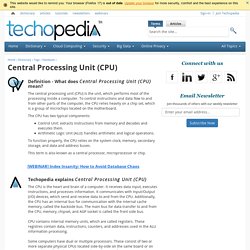
It receives data input, executes instructions, and processes information. It communicates with Input/Output (I/O) devices, which send and receive data to and from the CPU. See How the CPU Works In One Lesson. How a CPU is made. Central processing unit. A Pentium CPU inside a computer A central processing unit (CPU) is an important part of almost every computer.
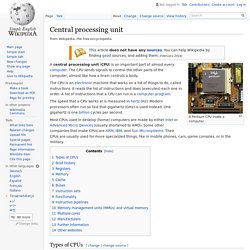
The CPU sends signals to control the other parts of the computer, almost like how a brain controls a body. The CPU is an electronic machine that works on a list of things to do, called instructions. It reads the list of instructions and does (executes) each one in order. What is Cache Memory? - Definition from Techopedia. BBC Bitesize - GCSE Computer Science - Introducing computers - Revision 3. Single dual and multi core processor.
What does the CPU do ; how is the CPU affected by clock speed, cache memory and number of cores. CPU Clock Speeds: Guide to the A+ Certification Exam (04:04) How Do CPUs Use Multiple Cores? OCR GCSE Computing: CPU - Topic 2. 1.1 How common characteristics of CPUs affect their performance. Teach ICT GCSE Computer Science 9-1 OCR J276 CPU performance. 20_Activity1. Complete the following sentences by dragging the words from the list below into the spaces provided.
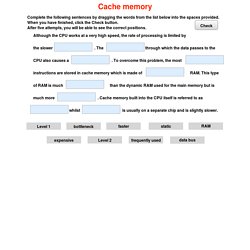
When you have finished, click the Check button.After five attempts, you will be able to see the correct positions. Level 2 Although the CPU works at a very high speed, the rate of processing is limited by Level 1 frequently used is usually on a separate chip and is slightly slower. data bus bottleneck static Show . Faster of RAM is much . Expensive Well done! What is Clock Speed? - Definition from Techopedia. A faster clock speed can speed up processing, but increasing the clock speed at an accelerated rate can sometimes be harmful to a PC, especially if other components are not upgraded.

Depending on the CPU, it can process one or more instructions per clock pulse. Newer PCs can process more than one instruction per clock pulse and usually have a larger bus, which determines how fast data on the motherboard is moving. What is Multicore? - Definition from Techopedia. Central processing unit. The form, design and implementation of CPUs have changed over the course of their history, but their fundamental operation remains almost unchanged.
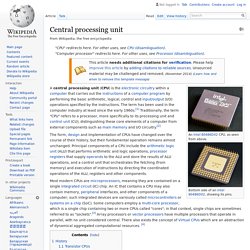
Principal components of a CPU include the arithmetic logic unit (ALU) that performs arithmetic and logic operations, processor registers that supply operands to the ALU and store the results of ALU operations, and a control unit that orchestrates the fetching (from memory) and execution of instructions by directing the coordinated operations of the ALU, registers and other components. Most modern CPUs are microprocessors, meaning they are contained on a single integrated circuit (IC) chip. An IC that contains a CPU may also contain memory, peripheral interfaces, and other components of a computer; such integrated devices are variously called microcontrollers or systems on a chip (SoC).
History[edit] EDVAC, one of the first stored-program computers Transistor CPUs[edit] Small-scale integration CPUs[edit] Large-scale integration CPUs[edit] BBC Bitesize - GCSE Computer Science - CPU and memory - Revision 3. BBC Bitesize - GCSE Computer Science - CPU and memory - Revision 2. What is CPU Cache? 10 Fetch Execute cycle. OCR GCSE Computing: CPU - Topic 2. 1.1 How common characteristics of CPUs affect their performance. 7_Activity1. 20_Activity1. Central processing unit. The form, design and implementation of CPUs have changed over the course of their history, but their fundamental operation remains almost unchanged.

Principal components of a CPU include the arithmetic logic unit (ALU) that performs arithmetic and logic operations, processor registers that supply operands to the ALU and store the results of ALU operations, and a control unit that orchestrates the fetching (from memory) and execution of instructions by directing the coordinated operations of the ALU, registers and other components.
Most modern CPUs are microprocessors, meaning they are contained on a single integrated circuit (IC) chip. An IC that contains a CPU may also contain memory, peripheral interfaces, and other components of a computer; such integrated devices are variously called microcontrollers or systems on a chip (SoC). History[edit] EDVAC, one of the first stored-program computers Transistor CPUs[edit] Small-scale integration CPUs[edit] Large-scale integration CPUs[edit]
Cambridge GCSE Computing Online - supporting the GCSE in Computing Science from OCR. BBC Bitesize - GCSE Computer Science - CPU and memory - Revision 3. See How the CPU Works In One Lesson. Intro to Computer Architecture. Intro to Computer Architecture. 10 Fetch Execute cycle. 8_Activity1. 7_Activity2. 7_Activity1. Teach ICT GCSE Computer Science 9-1 OCR J276 Von Neumann architecture. In the early days of computing (1940s), computers were built to carry out a very specific task, for example breaking secret wartime codes.
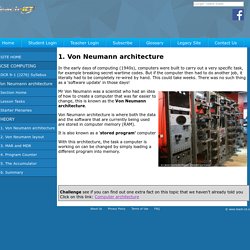
But if the computer then had to do another job, it literally had to be completely re-wired by hand. This could take weeks. There was no such thing as a 'software update' in those days! Mr Von Neumann was a scientist who had an idea of how to create a computer that was far easier to change, this is known as the Von Neumann architecture. What is Computer Architecture? - Definition from Techopedia. A very good example of computer architecture is Von Neumann architecture, which is still used by most types of computers today.
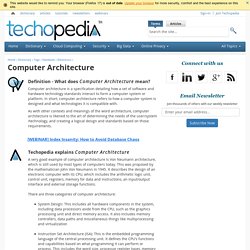
This was proposed by the mathematician John Von Neumann in 1945. It describes the design of an electronic computer with its CPU, which includes the arithmetic logic unit, control unit, registers, memory for data and instructions, an input/output interface and external storage functions. There are three categories of computer architecture:System Design: This includes all hardware components in the system, including data processors aside from the CPU, such as the graphics processing unit and direct memory access. It also includes memory controllers, data paths and miscellaneous things like multiprocessing and virtualizationInstruction Set Architecture (ISA): This is the embedded programming language of the central processing unit.
Accumulator (computing) Accumulators on a tabulating machine circa 1936.
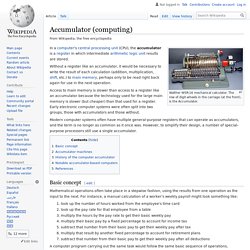
Each of the four registers can store a 10-digit decimal number. In a computer's central processing unit (CPU), an accumulator is a register in which intermediate arithmetic and logic results are stored. Modern computer systems often have multiple general purpose registers that operate as accumulators, and the term is no longer as common as it once was. Program counter. Front panel of an IBM 701 computer introduced in 1952.
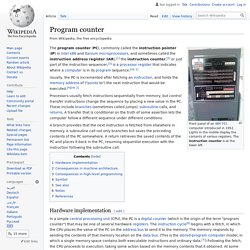
Lights in the middle display the contents of various registers. The instruction counter is at the lower left. The program counter (PC), commonly called the instruction pointer (IP) in Intel x86 and Itanium microprocessors, and sometimes called the instruction address register (IAR),[1] the instruction counter,[2] or just part of the instruction sequencer,[3] is a processor register that indicates where a computer is in its program sequence. Memory data register. Memory address register. In a computer, the Memory Address Register (MAR) is CPU register that either stores the memory address from which data will be fetched to the CPU or the address to which data will be sent and stored.
In other words, MAR holds the memory location of data that needs to be accessed. Von Neumann architecture. Computer architecture where code and data share a common bus A von Neumann architecture scheme The von Neumann architecture—also known as the von Neumann model or Princeton architecture—is a computer architecture based on a 1945 description by John von Neumann and others in the First Draft of a Report on the EDVAC.[1] That document describes a design architecture for an electronic digital computer with these components:
Teach ICT GCSE Computer Science 9-1 OCR J276 Computer Systems. The CPU is often described as the 'brain' of the computer (although that isn't a technical term so don't write it in an exam). The CPU is an electronic chip called a microprocessor. The CPU fetches instructions from memory (RAM), it decodes the instructions and then executes those instructions. The instructions are provided by a computer program. The purpose of the CPU is to process data. It is where all the searching, sorting, calculating and decision making takes place in the computer. So no matter what you do on your computer, whether it be writing an essay, looking at your photographs or checking your emails, the CPU has dealt with all of the data and processing required to make these tasks possible.
BBC Bitesize - GCSE Computer Science - CPU and memory - Revision 1. Youtube. 09 The CPU. OCR GCSE Computing: CPU - Topic 2. OCR GCSE Computing: CPU - Topic 2. 1.1 The von Neumann architecture. What is an Embedded System? - Definition from Techopedia. Embedded Systems (1).flv. 1.1 Embedded systems. 1. Introduction to Embedded Systems. Course About Video. Embedded system. An embedded system is a computer that has been built to solve only a few very specific problems and is not easily changed.[1] In contrast, a general-purpose computer can do many different jobs, and can be changed at any time with new programs for new jobs. An embedded system usually does not look like a computer, often there is no keyboard or monitor or mouse. But like any computer it has a processor and software, input and output.
The word embedded means it is built into the system. It is a permanent part in a bigger system. For example, the controller embedded in an elevator tells the motor to move the elevator to different floors, based on buttons that are pushed. Embedded systems control many of the common devices in use today, from card readers in hotel door locks to many controls in a car. Examples of embedded systems[change | change source] Embedded systems are used everywhere in modern life, including: Common features[change | change source] User interfaces[change | change source]